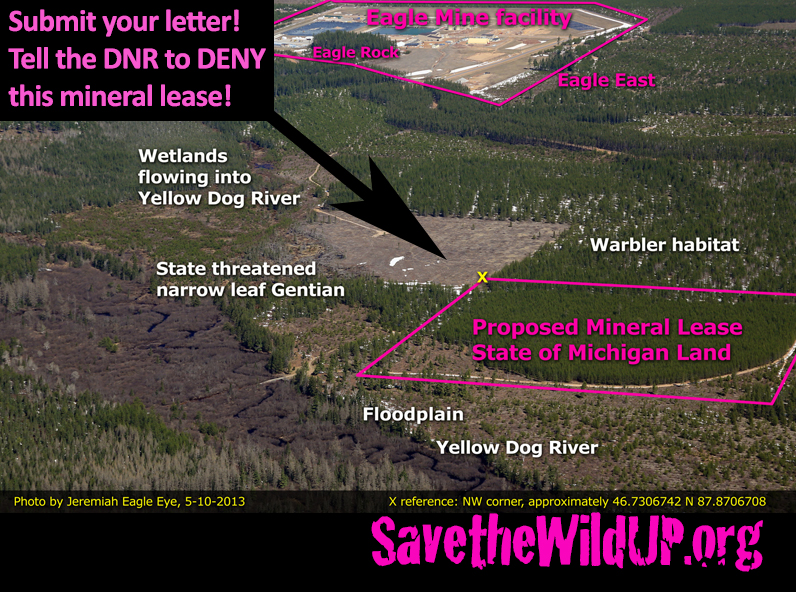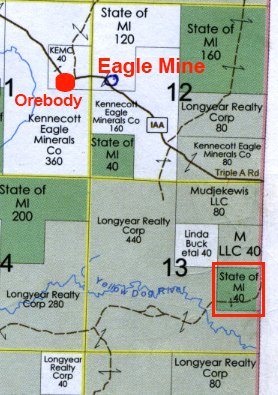Concerned citizens from across the U.P., residents of Humboldt township, members of the grassroots organization Save the Wild U.P. (SWUP), members of the Keweenaw Bay Indian Community (KBIC), and others gathered at the Westwood High School in Ishpeming on Tuesday night, to discuss a draft National Pollutant Discharge Elimination System (NPDES) Permit for Eagle Mine’s Humboldt Mill.
The Michigan Department of Environmental Quality (MDEQ) held the Public Hearing to discuss a proposed “reissuance” of an expired NPDES Permit, which originally authorized Eagle Mine’s Humboldt Mill to discharge wastewater into a wetland located between the Humboldt Pit and US-41.
During the hearing, residents raised serious questions and provided critical feedback to the MDEQ. Many believe that draft permit will degrade water quality in the Escanaba River. Unresolved environmental issues plague Humboldt Mill. Tailings produced by Eagle will be deposited into an existing pit, adding to legacy contamination. There is an ongoing investigation by the Environmental Protection Agency (EPA) regarding the mill’s status as a Superfund site. An additional outflow pipe was recently built between the tailings pit and wetlands of the Escanaba River without permits or public involvement. Residents are especially alarmed by increased discharges— 2.8 million gallons per day (MGD), compared with 0.82 MGD in the first permit. The new discharge pipe (“Outfall 002”) will handle 50% of that discharge.
“As we learned at the State hearing Tuesday night, in addition to problems like flooding the private property of nearby residents, MDEQ’s proposed NPDES permit for discharges at the Humboldt Mill is inconsistent with federal law and it fails to protect the Escanaba River Watershed that once was cherished fishing ground,” said former federal offshore oil regulator and KBIC tribal member Jeffery Loman. “I intend to hold the EPA accountable for these failures. The EPA is responsible for overseeing the Clean Water Act and they are the trustee for treaty-protected tribal resources at stake here.”
During the hearing, Steve Casey, MDEQ’s District Supervisor of Water Resources, seemed uncertain as to why baseline environmental assessment were needed for a wetland receiving NPDES discharges, or why “additive impacts” (such as legacy pollution of wetlands and sediment scouring) must be calculated before a NPDES permit is granted. According to the Environmental Protection Agency, “Agencies have an obligation to evaluate waters in terms of how they interrelate and function as ecosystems rather than as individual units, especially in the context of complex ecosystems where their integrity may be compromised by environmental harms that individually may not be measurably large but collectively are significant.”
“The MDEQ was obviously unprepared for the level of precision shown in the commentary at this public hearing. But our community has been tirelessly committed to protecting our land and water from mining interests for more than ten years now. We know that regulators aren’t enforcing the rules and are instead relaxing them to benefit multinational mining companies — threatening our clean water as well as our democratic process,” said Alexandra Maxwell, SWUP’s Interim Director.
Residents voiced concerns over numerous changes (deemed “Insignificant Changes” by MDEQ staff) which have allowed Eagle Mine to radically change plans for Eagle Mine and Humboldt Mill, violating Michigan’s Nonferrous Mining Regulations. Under Part 632, Eagle’s permits require amendment. There was no public input or environmental impacts assessment for construction of a pipeline terminating at the newly-constructed “Outfall 002” — this significant structure and related wetland impacts were deemed “insignificant” — yet the draft NPDES permit will authorize use of the outfall, a clear violation of due process. The public was not notified when the location of Humboldt’s Water Treatment Plant (WTP) was switched, and the draft permit fails to mention the WTP’s treatment capacity, 1.44 MGD. Given the WTP’s design flaws, up to 50% of Humboldt’s wastewater discharges may bypass the treatment plant, sending the mill’s tailings water directly into the environment. “Environmental concerns and due process concerns are one and the same,” said attorney Jana Mathieu.
Richard Sloat was angered by the permit’s failure to require stream monitoring or discharge monitoring. “Water temperature data is not being recorded for the Escanaba River. This pipe will discharge ‘treated or untreated’ waste into that river. There is only one instance of a recorded temperature at the water treatment plant, documented because of a contamination leak in September, when the wastewater temperature reached 78.1 degrees — they want to discharge warm water into the Escanaba River, a cold-water fishery, in September?!”
“I find it outrageous that MDEQ and Eagle Mine failed to consider the environmental impacts of increased discharges — 240% more! — authorized by this permit!” said Kathleen Heideman, SWUP president. “No baseline information was provided, either for the wetland or the Middle Branch of the Escanaba River. Eagle Mine’s original permit failed to evaluate these sites, and now they want to dump wastewater into unassessed ecosystems! No wetland hydrology or biology data was included in the draft permit, so there’s no way to calculate the risks, and the certain degradation that will result.”
Water quality will clearly be undermined by this permit, a violation of the Clean Water Act, but Eagle Mine is seeking an exemption in its Antidegradation Demonstration, stating that the lowering of water quality is necessary for “important social and economic development in the area” — however the Humboldt Township Board announced during Tuesday night’s hearing that they were unanimously opposed to the permit. Concerned citizens and representatives of the Keweenaw Bay Indian Community (KBIC) raised objections to Eagle’s Antidegradation Demonstration, collectively requesting updated and comprehensive proof of the social and economic benefits.
Residents are concerned about the enormous increase in discharge — from 0.82 to 2.8 million gallons per day (MGD). Both mass limits and concentration limits for pollutants have been increased, allowing more pollution of wetlands, and the Escanaba River. The first NPDES permit allowed discharge from only a single pipe (“Outfall 001”).
Pollutant limits are substantially increased for multiple parameters, according to the draft NPDES permit. Below are two tables showing increased limits for quantity (Figure 1) and increased limits for concentration (Figure 2):
Attorney Michelle Halley, who has worked extensively on Eagle Mine issues, said, “This NPDES permit allows discharges to the Escanaba River that do not protect the fishery. Because of that, it violates the Clean Water Act.”
“It is important to remember that ore being processed at the Humboldt Mill comes from Eagle Mine, containing valuable copper and nickel — along with dangerous sulfides, salts, and a long list of toxic metals,” said Maxwell. Water monitoring at Eagle Mine has documented more than 100 exceedances of groundwater discharge limits since the permit was issued in 2007, including serious exceedances of arsenic, copper, lead, molybdenum, silver, and vanadium — and uranium levels in water at the Eagle Mine facility have risen to 103 ug/L, more than 3 times higher than the EPA’s Maximum Concentration Level. Since uranium monitoring was not included in Eagle Mine’s permit, the mine claims that no permit violation has occurred.
To protect aquatic life, conservative water quality standards should be calculated for all potential contaminants. The draft NPDES permit fails to list limits for many contaminants, including: Aluminum, Antimony, Barium, Boron, Calcium, Chromium, Fluoride, Iron, Lithium, Magnesium, Molybdenum, Potassium, Silver, Sodium, Thallium, Tin, Titanium, Strontium, Sulfate, Vanadium, and Uranium.
“The problem really boils down to a regulatory process focused on permitting rather than preventing pollution,” said Steve Garske, SWUP Board member and western U.P. resident. If contaminants are present in the ore from Eagle Mine, it is reasonable to expect they will also be present in Humboldt Mill’s tailings. It is unclear why discharge limits at the mill do not reflect known contaminants from the mine, and all legacy contaminants previously found in testing of the Humboldt site.
At the hearing, MDEQ’s Steve Casey provided a brief update on Eagle Mine’s Groundwater Discharge Permit, which was considered deeply flawed by concerned citizens. Casey acknowledged Eagle’s ongoing vanadium exceedances, shared some theories as to why contaminant levels might be increasing in the groundwater — and confirmed that MDEQ has still not approved Eagle Mine’s Groundwater Discharge Permit, which expired two years ago. “You cannot understand the impacts of this endeavor until you understand the water,” said Cynthia Pryor, watershed resident and longtime community watchdog. “Neither the mining company nor MDEQ understand how hydrogeology functions at the Eagle Mine and at the Humboldt Mill.”
View Save the Wild U.P.’s written comments re: Proposed NPDES Permit, MI-0058649, submitted to the Michigan Department of Environmental Quality and the Environmental Protection Agency on January 16, 2015 (PDF)




